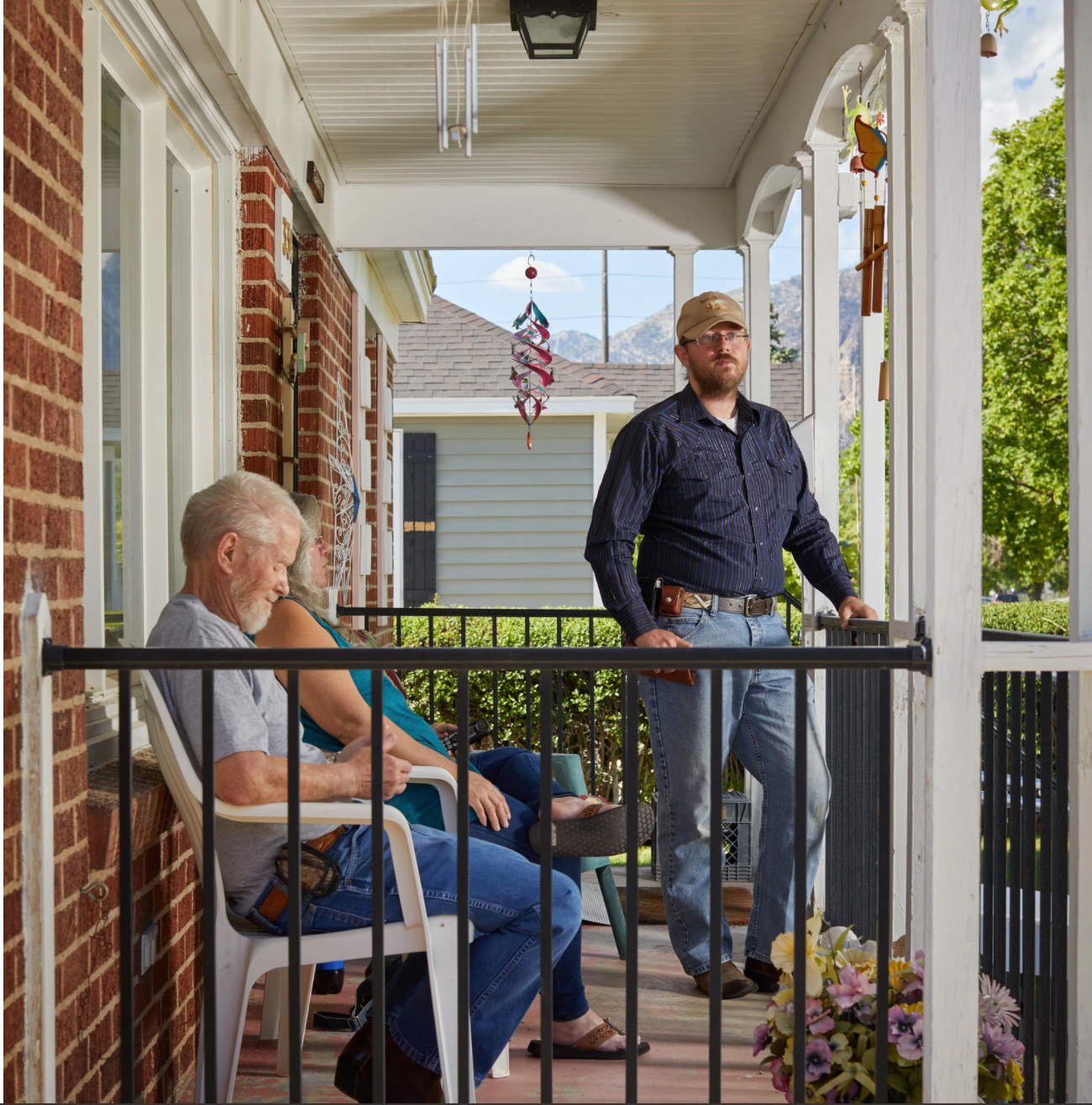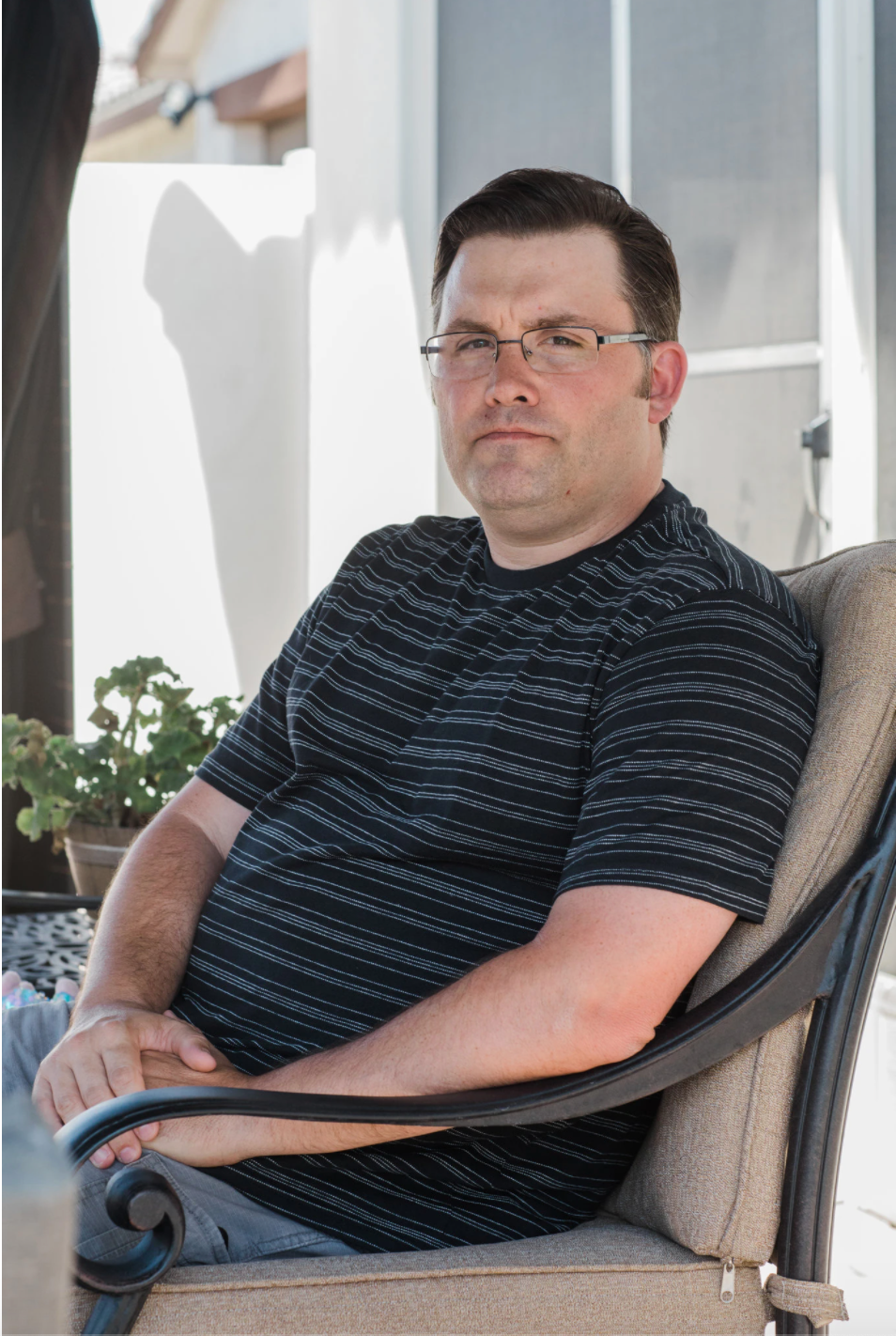By Sarah Butrymowicz and

Tyler Hutchinson, standing, dropped out of American Public University after one semester because, he said, the college never disbursed his federal financial aid. Credit: Lindsay D’Addato for The New York Times
In March, as colleges and universities shuttered campuses under a nationwide lockdown, Strayer University updated its website with a simple message: “Great things can happen at home.”
Capella University, owned by the same company as Strayer, has run ads promoting its flexibility in “uncertain times” and promising would-be transfer students that they can earn a bachelor’s degree in as little as a year.
Online for-profit colleges like these have seen an opportunity to increase enrollment during the coronavirus pandemic. Their flexible programs may be newly attractive to the many workers who have lost their jobs, to college students whose campuses are closed, and to those now seeking to change careers. The colleges’ parent companies often have substantial cash reserves that they can pump into tuition discounts and marketing at a time when public universities and nonprofit colleges are seeing their budgets disintegrate.
Few of the largest for-profit colleges operating primarily online have track records to justify the optimistic advertising pitches. Some have put students deep in debt while posting dismal graduation rates amid a history of investigations by state and federal agencies, including many that have led to substantial financial settlements.
Still, there is evidence that interest in the schools has increased.
“I hate to call anybody a winner in this crisis,” said Jeffrey M. Silber, managing director at BMO Capital Markets, a financial services company, “but I think growth will increase this fall and could continue thereafter.”
For-profit colleges have long devoted large sums to advertising, spending almost $400 per student in 2017, according to research from the Brookings Institution. For nonprofit institutions, that figure was $48, and for public colleges it was $14.
“Unfortunately, because of the financial distress a lot of not-for-profits are facing, they may have to cut back on marketing,” Mr. Silber said. “I think the for-profits may be at a competitive advantage.”
Ashford University has received so many new inquiries in recent months that it has announced plans to hire 200 additional “enrollment advisers” to field them. Another school that operates largely online, Grand Canyon University, says it has had a surge in enrollments. (Grand Canyon has nonprofit status in Arizona and with the Internal Revenue Service but is designated as a for-profit institution by the U.S. Department of Education.) Capella and Strayer have reported increases in requests for information.
The trend concerns many student-protection advocacy groups, which point out that the colleges that stand to gain are among those with the most troubling records. For the most part, the largest online for-profit universities have poor graduation rates — often no higher than 25 percent, and sometimes as low as in the single digits. Several have been accused of intentionally misleading students about potential job prospects to persuade them to enroll and often to take on tens of thousands of dollars in debt.
Eileen Connor, the legal director at the Project on Predatory Student Lending at Harvard Law School, said she was worried by the prospect of a resurgence for online, for-profit schools.
“In times of economic downturn, that’s when the for-profit colleges start to thrive,” she said. Online colleges “have a running start, especially now, when there’s an economic downturn keeping people in their homes,” she added. “That is a perfect storm for the thing that they’re trying to do.”
These schools often attract low-income, nontraditional college students who tend to have lower completion rates than those who enroll straight from high school and attend full time. Many have family pressures that interfere with study.
In recent earnings calls, many companies emphasized the quality of the education they provide. Karl McDonnell, the chief executive of Strategic Education Inc., the parent company of Capella and Strayer, told investors in March, “We’re going to continue to focus on maintaining the highest possible academic quality figuring that that’s really the best way to sort of position yourself vis-à-vis any kinds of regulatory or legislative initiatives.”
In the first quarter, Strategic Education took in $46.5 million in profit, up from $36.7 million over the same quarter last year. Its executive chairman, Robert Silberman, told investors that the company had a “fortress balance sheet with over $500 million in cash.”
Before the broad market decline last week, Strategic’s stock price had climbed steadily since early April, as had those of other publicly traded companies that own universities and college-related education services, including Grand Canyon Education Inc., Perdoceo Education Corporation and Zovio. But for many of their students, the future is precarious.
At Capella, only 11 percent of undergraduates earn a degree within eight years, according to the most recent federal statistics. At Strayer, graduation rates range from 3 percent at its Arkansas campus to a high of 27 percent in Virginia.
Fewer than a third of students at Perdoceo campuses graduate within eight years. The company’s schools were recently barred from receiving G.I. Bill money from new students after the Department of Veterans Affairs found that they had used sales and enrollment practices that were “erroneous, deceptive or misleading.”
Ashford University, owned by Zovio, had a 25 percent graduation rate, according to the most recent federal data. Those completing degrees had a median debt of $34,000 on leaving. Zovio is being sued by the California attorney general, accused of making false promises to students and using illegal debt collection practices. The company denies any wrongdoing.
For-profit schools made a similar play for students during the 2008 recession, as people searching for work in a shrinking job market sought new credentials at low cost. Enrollment at for-profit colleges climbed 24 percent at the height of the recession, according to an analysis by BMO Capital Markets.
Along with that surge came increased scrutiny. Government investigators concluded that two of the biggest for-profit operators, Corinthian Colleges Inc. and ITT Technical Institute, had mismanaged or failed to account for millions of dollars in federal financial aid. They were subsequently barred from receiving such aid, which led to their collapse. The companies were also accused of pushing students to take loans they could never expect to repay.
The Obama administration put rules in place to shut down programs whose graduates didn’t earn enough to pay back their student debt and to make it easier for students who had been defrauded to have their loans forgiven. Experts say conditions are ripe for new growth in the for-profit sector because the Trump administration has rolled back those changes.
“A lot of the pieces are in place to be right back where we were in 2008, and the regulations that had come out of lessons learned are being whittled away,” said Yan Cao, a fellow at the liberal-leaning Century Foundation who studies higher education.
The Trump administration’s Department of Education has disputed criticism of its oversight of for-profit colleges. It notes that it has expanded information on its websites to help students make informed choices.

Shawn Cooper says he was twice given the go-ahead on his dissertation project at Capella University, only to be told to start over. Credit: Caitlin O’Hara for The New York Times
Shawn Cooper, an Air Force veteran, said he was twice given approval for his dissertation project at Capella and worked on it for months, only to be told that he needed to start over with a new topic. He said he was forced to leave, despite a 4.0 grade-point average.
Mr. Cooper says he owes more than $100,000 in student loans after his time at Capella. “At the end of the day, I feel like it’s all just a facade on their end,” he said. “Get people in, take their money and get them out, usually without anything to show for it.”
A lawsuit was filed against Capella seeking class-action status for students like Mr. Cooper who say the school intentionally and needlessly prolonged their doctoral programs, costing them tens of thousands of dollars. Last year, a judge allowed three counts in the suit to continue, all regarding the time it took a “typical” student to complete programs, but dismissed most other counts, including those about how long the programs were “designed” or “structured” to take.
Strategic Education officials did not reply to requests for comment.
Angela Selden, the chief executive of American Public Education Inc., which owns American Public University and American Military University, told investors that the company has started spending part of its marketing budget originally earmarked for later this year. “The pandemic has created an unexpected opportunity,” Ms. Selden said.
Wallace Boston, the president of American Public’s two universities, said both schools offered a high-quality education. “People who are critical of the sector on a whole tend to be looking at things on the surface, and marketing is one of the things they pick on the most,” Mr. Boston said. “I don’t think that those critics are justified unless they do their homework.”
Relative to some other online-only institutions, the American Public University System is cheaper, at $6,880 a year in tuition and fees, and has higher graduation rates. Still, 22 percent of American Public University’s 36,000-plus students graduate after eight years, according to the most recent federal data.
Mr. Boston said the university allowed students to take up to a decade to complete their programs. The most recent 10-year graduation rate was 35 percent, he added.
Tyler Hutchinson, of Brigham City, Utah, enrolled at American Public University in 2017. He had three children and worked part time, so the flexibility of taking online classes offered hope a degree in environmental science that would lead to a well-paying job.
But Mr. Hutchinson, 31, dropped out after one semester because, he said, the college did not disburse his federal financial aid. The school also sent him a bill for more than $1,000 for classes the next semester that he had never signed up for, he said — a bill that has been sold to a collection agency.
Mr. Boston said the university could not provide information about a student without the student’s consent. Mr. Hutchinson gave his consent by email, but a spokesman said the university needed a formal consent filing and would have no further comment.
Having been laid off at a convenience store and with his work as a United States Census worker suspended because of the coronavirus pandemic, Mr. Hutchinson has no income.
“When they advertised, what got me was the work-life balance. And with financial aid, it was really attractive,” he said. “Even though I really enjoyed it, the financials were such a burden we just decided to discontinue.”
American Public Education Inc.’s net income of $2.4 million in the first three months of 2020 was more than double that of the same period last year, and on June 9 its stock price hit its highest closing point in a year.
Filed in: In the News, Uncategorized OCP
Contact Office of Clinical and Pro Bono Programs
Website:
hls.harvard.edu/clinics
Email:
clinical@law.harvard.edu